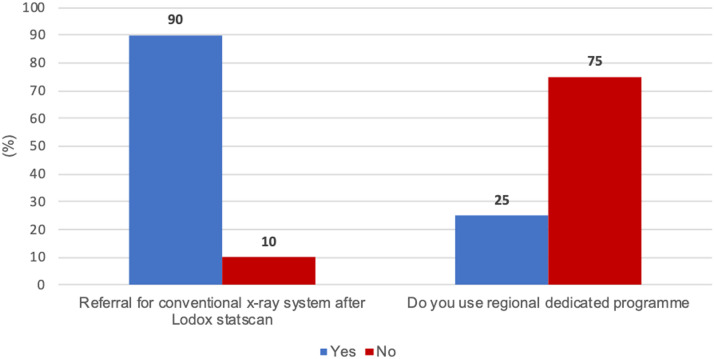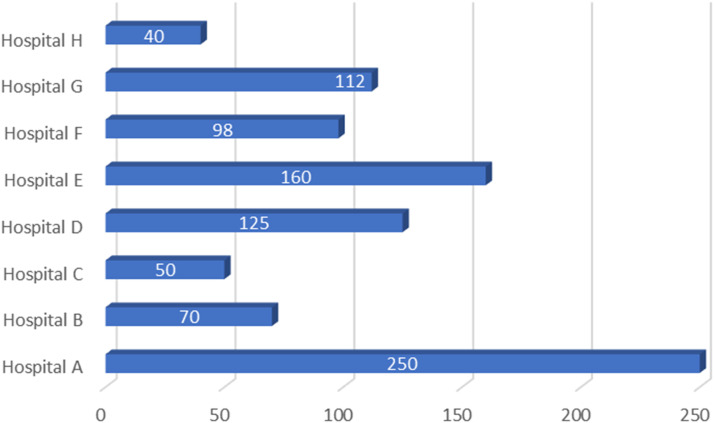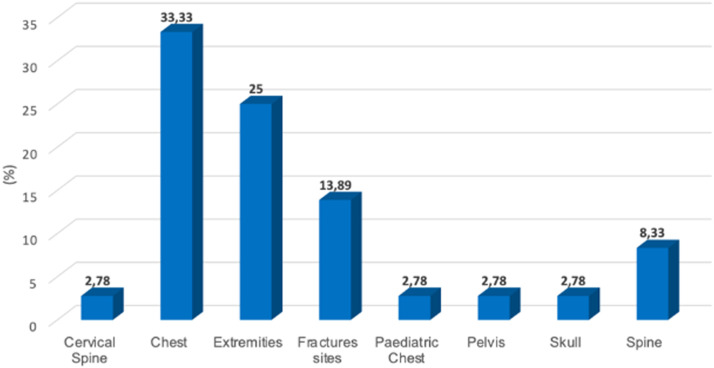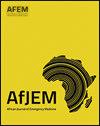下载PDF
{"title":"对南非全身低剂量x射线成像系统使用的调查:放射技师的观点","authors":"Muchui Julius Thambura","doi":"10.1016/j.afjem.2023.05.009","DOIUrl":null,"url":null,"abstract":"<div><h3>Introduction</h3><p>A low dose x-rays alias Lodox© statscan was originally developed in South Africa to detect smuggled diamonds in the mines. Later, hospital trauma units began to use it as a screening tool for gross pathology on trauma patients. This imaging system became popular because of its use of low radiation doses and its ability to perform anterior posterior (head to toe image) image in under 13 seconds. Anecdotal evidence confirms that patients were referred for additional regional images on conventional x-ray systems after Lodox imaging. Thus, patients were subjected to additional ionising radiation, long waiting times as well as additional charges for secondary radiological examinations.</p></div><div><h3>Objective</h3><p>This research aimed at investigating the extent to which Lodox was used in trauma units (n=28) in South Africa.</p></div><div><h3>Method</h3><p>In this descriptive cross-sectional research. researcher invited one radiographer from each of the 28 hospitals in South Africa that were using Lodox.</p></div><div><h3>Results</h3><p>Out of twenty radiographers who responded, it was found that most hospitals were referring patients for additional conventional x-ray images (Figure 1); for example, for chest x-rays. This was done despite the patient having undergone radiological procedures and examinations by the Lodox imaging system that was similar to those performed by conventional x-ray systems.</p></div><div><h3>Conclusion</h3><p>Lodox was used for a successful diagnosis Thus, researcher recommends an imaging protocol for Lodox to be developed for guiding the referral of patients after the Lodox scanning has been performed.</p></div>","PeriodicalId":48515,"journal":{"name":"African Journal of Emergency Medicine","volume":null,"pages":null},"PeriodicalIF":1.4000,"publicationDate":"2023-09-01","publicationTypes":"Journal Article","fieldsOfStudy":null,"isOpenAccess":false,"openAccessPdf":"https://www.ncbi.nlm.nih.gov/pmc/articles/PMC10491940/pdf/","citationCount":"0","resultStr":"{\"title\":\"An investigation into the use of Full-body Low Dose X-rays Imaging system in South Africa: Radiographer's perspective\",\"authors\":\"Muchui Julius Thambura\",\"doi\":\"10.1016/j.afjem.2023.05.009\",\"DOIUrl\":null,\"url\":null,\"abstract\":\"<div><h3>Introduction</h3><p>A low dose x-rays alias Lodox© statscan was originally developed in South Africa to detect smuggled diamonds in the mines. Later, hospital trauma units began to use it as a screening tool for gross pathology on trauma patients. This imaging system became popular because of its use of low radiation doses and its ability to perform anterior posterior (head to toe image) image in under 13 seconds. Anecdotal evidence confirms that patients were referred for additional regional images on conventional x-ray systems after Lodox imaging. Thus, patients were subjected to additional ionising radiation, long waiting times as well as additional charges for secondary radiological examinations.</p></div><div><h3>Objective</h3><p>This research aimed at investigating the extent to which Lodox was used in trauma units (n=28) in South Africa.</p></div><div><h3>Method</h3><p>In this descriptive cross-sectional research. researcher invited one radiographer from each of the 28 hospitals in South Africa that were using Lodox.</p></div><div><h3>Results</h3><p>Out of twenty radiographers who responded, it was found that most hospitals were referring patients for additional conventional x-ray images (Figure 1); for example, for chest x-rays. This was done despite the patient having undergone radiological procedures and examinations by the Lodox imaging system that was similar to those performed by conventional x-ray systems.</p></div><div><h3>Conclusion</h3><p>Lodox was used for a successful diagnosis Thus, researcher recommends an imaging protocol for Lodox to be developed for guiding the referral of patients after the Lodox scanning has been performed.</p></div>\",\"PeriodicalId\":48515,\"journal\":{\"name\":\"African Journal of Emergency Medicine\",\"volume\":null,\"pages\":null},\"PeriodicalIF\":1.4000,\"publicationDate\":\"2023-09-01\",\"publicationTypes\":\"Journal Article\",\"fieldsOfStudy\":null,\"isOpenAccess\":false,\"openAccessPdf\":\"https://www.ncbi.nlm.nih.gov/pmc/articles/PMC10491940/pdf/\",\"citationCount\":\"0\",\"resultStr\":null,\"platform\":\"Semanticscholar\",\"paperid\":null,\"PeriodicalName\":\"African Journal of Emergency Medicine\",\"FirstCategoryId\":\"3\",\"ListUrlMain\":\"https://www.sciencedirect.com/science/article/pii/S2211419X23000289\",\"RegionNum\":4,\"RegionCategory\":\"医学\",\"ArticlePicture\":[],\"TitleCN\":null,\"AbstractTextCN\":null,\"PMCID\":null,\"EPubDate\":\"\",\"PubModel\":\"\",\"JCR\":\"Q3\",\"JCRName\":\"EMERGENCY MEDICINE\",\"Score\":null,\"Total\":0}","platform":"Semanticscholar","paperid":null,"PeriodicalName":"African Journal of Emergency Medicine","FirstCategoryId":"3","ListUrlMain":"https://www.sciencedirect.com/science/article/pii/S2211419X23000289","RegionNum":4,"RegionCategory":"医学","ArticlePicture":[],"TitleCN":null,"AbstractTextCN":null,"PMCID":null,"EPubDate":"","PubModel":"","JCR":"Q3","JCRName":"EMERGENCY MEDICINE","Score":null,"Total":0}
引用次数: 0
引用
批量引用





